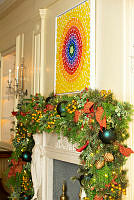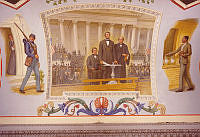
Treasures of the White House: Sand Dunes at Sunset, Atlantic City
995.1759.1
One of Henry Ossawa Tanner's largest and most artistically ambitious landscape paintings is this beautiful coastal view of Atlantic City, New Jersey. Depicted in the late afternoon light, windswept sand dunes appear before an ocean covered with a low haze that partially hides the sun. Upon close examination, one can see that the artist incorporated sand into the paint used to create the sand dunes.
Enticed by seasonal employment opportunities, Tanner visited Atlantic City many times during the summers of the 1870s and 1880s. Dewey F. Mosby in his biography of Tanner has suggested that this painting may originally have been entitled, Back from the Beach, and was exhibited at the Pennsylvania Academy in 1885 and again at the National Academy in 1886.
Tanner, the son of an African Methodist Episcopal minister and a mother who conducted private school in her home, was born in Pittsburgh, Pennsylvania in 1859. At the age of twenty, he enrolled in the Pennsylvania Academy of Fine Arts and studied under Thomas Eakins and Thomas Hovenden. Although he spent over half of his life in France where he found an expansive and more accepting environment, he always considered himself an American. He made periodic visits to the United States and served as a lieutenant with the American Red Cross during World War I. On May 25, 1937, he died at his home in Paris.
This is the first work of art by an African-American artist to be part of the White House collection. Acquired from Dr. Rae Alexander-Minter, grandniece of the artist, it was donated to the White House by the White House Endowment Fund.
Source: Office of the Curator, The White House
- Artist
- Henry Ossawa Tanner (1859-1937)
- Medium
- Oil on canvas, c. 1885, 30 1/8 x 59 1/2 in.
- Credit
- Gift of the White House Endowment Fund, 1995.














